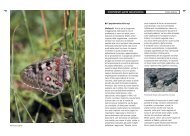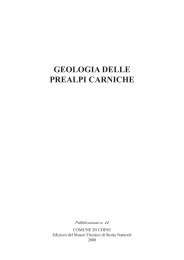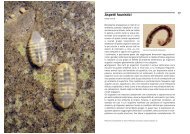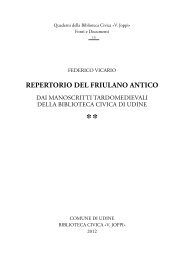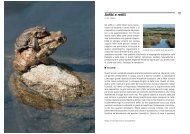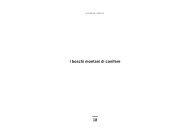Despite its inhospitable appearance and lack of any ... - Udine Cultura
Despite its inhospitable appearance and lack of any ... - Udine Cultura
Despite its inhospitable appearance and lack of any ... - Udine Cultura
Create successful ePaper yourself
Turn your PDF publications into a flip-book with our unique Google optimized e-Paper software.
72<br />
Styg<strong>of</strong>aunal provinces in Italy<br />
The area was affected by karstification<br />
in the late Miocene, <strong>and</strong> hosts m<strong>any</strong><br />
palaeo-endemics. Exclusive to the<br />
karstic vadose zone are harpacticoid<br />
copepods <strong>of</strong> the genus Morariopsis,<br />
the bathynellacean Bathynella<br />
skopljensis <strong>and</strong> the amphipod<br />
Niphargus stygius.<br />
Exceptional fauna, whose western<br />
limit <strong>of</strong> distribution is the Karst,<br />
populates large cavities filled with<br />
alkaline karstic water.<br />
Among these, there are polychaetes<br />
(Marifugia cavatica), gastropods<br />
(Belgr<strong>and</strong>ia stochi), ostracods (Cypria<br />
cavernae), calanoids (Troglodiaptomus<br />
sketi), <strong>and</strong> several cyclopoids <strong>and</strong><br />
Sphaeromides virei (ca. 1x)<br />
harpacticoids (like Acanthocyclops<br />
troglophilus <strong>and</strong> Nitocrella stochi). This area hosts the only Italian stygobiont<br />
isopods <strong>of</strong> the genus Asellus, those <strong>of</strong> the subgenus Microlistra, <strong>and</strong> the large<br />
Sphaeromides, as well as amphipods, which are highly diversified, with m<strong>any</strong><br />
endemics (e.g., Niphargus stochi, Hadzia fragilis). Other remarkable<br />
inhabitants are decapods <strong>of</strong> the genus Troglocaris, <strong>and</strong> the most famous<br />
stygobiont species, the olm (Proteus anguinus). Aquifers in marl <strong>and</strong><br />
s<strong>and</strong>stone also host very interesting fauna, with very different species from<br />
those found in adjacent karstic aquifers. Among the main biogeographical<br />
markers, there is the gastropod Istriana mirnae, <strong>and</strong> the large amphipods<br />
Niphargus spinulifemur <strong>and</strong> N. krameri.<br />
Alpine province. The Alpine styg<strong>of</strong>aunal province includes a very complex<br />
area associated with Alpine orogenetic events. It is divided into a northern part<br />
(strictly Alpine), above the southern limit <strong>of</strong> the great Quaternary glaciations,<br />
<strong>and</strong> a southern Pre-Alpine one, below which is the recent alluvial area <strong>of</strong> the<br />
Po Plain. The Alpine area is populated by only a few stygobionts: cold-loving,<br />
stenothermal species which followed the retreat <strong>of</strong> Quaternary glaciers <strong>and</strong><br />
colonised aquifers in carbonate <strong>and</strong> crystalline rocks in the Alps. In particular,<br />
a number <strong>of</strong> amphipods (Niphargus forelii, N. similis, N. strouhali) even live at<br />
high altitudes, above 2000 m, together with a few copepods <strong>and</strong><br />
bathynellaceans.<br />
73




